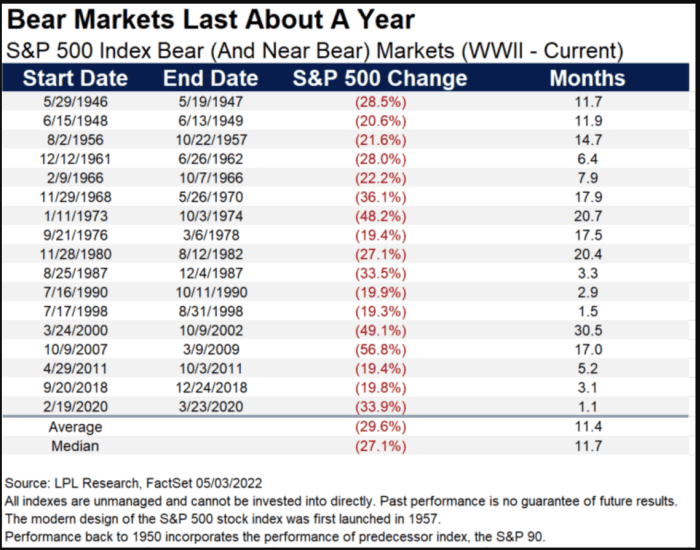This post was originally published on this site
The bear is back.
The S&P 500 on Monday was on track to confirm what many investors have been saying for months: The large-cap benchmark is in the grips of a bear market.
Stocks suffered sharp losses Monday after major benchmarks saw their worst week since January. Much of the weakness was attributed to the Friday reading of the May consumer-price index, which surged to 8.6% year-over-year — a 40-year high. Investors fear the Federal Reserve will have to raise rates even more aggressively than already expected, risking recession in their effort to tame inflation.
A close below 3,837.25 would mark a 20% pullback from the S&P 500’s Jan. 3 record finish, meeting the traditional definition of a bear market, according to Dow Jones Market Data. The S&P 500
SPX,
was down 3.3% at 3,772 in recent action.
Need to Know: The S&P 500 is clinging to a key support level after Friday’s meltdown, here’s what happens if that fails
The S&P 500 briefly traded below the bear-market threshold in May, but didn’t close below it. Stocks subsequently bounced, but the rebound has since given way as recession fears have increased.
The Dow Jones Industrial Average
DJIA,
dropped 740 points, or 2.4%, while the tech-heavy Nasdaq Composite
COMP,
which slumped into a bear market earlier this year, was down 4%.
To be sure, many investors and analysts see a 20% pullback as an overly formal if not outdated metric, arguing that stocks have long been behaving in bearlike fashion. And note, that if the S&P 500 were to close below the threshold, the start of the bear market would be backdated to the Jan. 3 peak. A bear market is declared over once the S&P 500 has risen 20% from a low.
How have stocks behaved once a bear market has been confirmed?
There have been 17 bear — or near-bear— markets since World War II, said Ryan Detrick, chief market strategist for LPL Financial, in a May note. Generally speaking, the S&P 500 has fallen further once a bear market begins. And, he said, bear markets have, on average, lasted about a year, producing an average peak-to-trough decline of just shy of 30%. (see table below).

LPL Research
Beyond the averages, there’s a lot of variability in the length and depth of past bear markets. The steepest fall, a peak-to-trough decline of nearly 57%, occurred in the 17 months that marked the 17-month bear market that accompanied the 2007-2009 financial crisis. The longest was a 48.2% drop that ran for nearly 21 months in 1973-74. The shortest was the nearly 34% drop that took place over just 23 trading sessions as the onset of the COVID-19 pandemic sparked a global rout that bottomed out on March 23, 2020, and marked the start of the current bull market.


